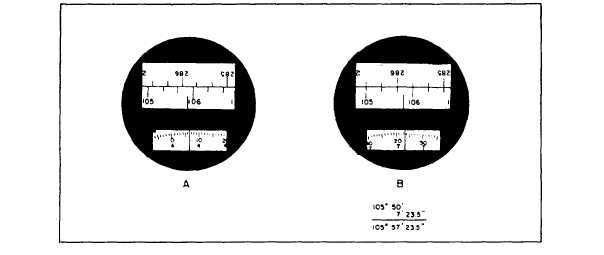circle (fig. 11-22) with lines spaced at 20-min
intervals, every third line numbered to indicate
a degree, and the image of the micrometer scale
on which the unit minutes and seconds are read.
The numbers increase in value (00 to 3600,
clockwise around the circle. The coincidence knob
on the side of, and near the top of, the right
standard is used in reading either of the circles.
The collimation level and its tangent screw are
used when the vertical circle is read.
The circles of the theodolite are read by the
COINCIDENCE METHOD in which optical
coincidence is obtained between diametrically
opposite graduations of the circle by turning the
MICROMETER or COINCIDENCE KNOB.
When this knob is turned, the images of the
opposite sides of the circle appear to move in
opposite directions across the field of the
CIRCLE-READING MICROSCOPE. The grad-
uations can be brought into optical coincidence
and appear to form continuous lines crossing the
dividing line. An index mark indicates the circle
graduations that are to be used in making the
coincidence. The index mark will be either in line
with a circle graduation or midway between two
graduations. The final coincidence adjustment
should be made between the graduations in line
with the index mark or when this index mark is
halfway between the two closest graduations.
HORIZONTAL CIRCLE.— To read the
HORIZONTAL CIRCLE, turn the INVERTER
or CIRCLE-SELECTOR KNOB until its black
line is horizontal. Adjust the illuminating mirror
to give uniform lighting to both sections of the
horizontal circle; the micrometer scale is viewed
through the circle-reading microscope. Focus the
microscope eyepiece so that the graduations are
sharply defined. The view through the microscope
should then be similar to figure 11-22, view A.
From this point, continue in the following way:
1. Turn the coincidence knob until the images
of the opposite sides of the circle are moved into
coincidence. Turning this knob also moves the mi-
crometer scale. The view through the microscope
now appears as shown in figure 11-22, view B.
2. Read the degrees and tens of minutes from
the image of the circle. The nearest upright
number to the left of the index mark is the number
of degrees (105). The diametrically opposite
number (the number ± 1800) is 285. The number
of divisions of the circle between the upright 105
and inverted 285 gives the number of tens of
minutes. In figure 11-22, view B, there are five
divisions between 105 and 285; and the reading,
therefore, is 105050´. The index may also be used
for direct reading of the tens of minutes. Each
graduation is treated as 20 min. Thus, the number
of graduations from the degree value to the index
mark multiplied by 20 min is the value. If the
index falls between graduations, another 10 min
is added when the tens of minutes is read directly.
3. Read the unit minutes and seconds below
from the image of the micrometer scale. This scale
has two rows of numbers below the graduations;
the bottom row is the unit minutes and the top
row, seconds. In figure 11-22, view B, the unit
minutes and seconds are read as 7'23.5''
4. Add the values determined in Steps 2 and 3
above. This gives 105057'23.5''as the final
reading.
Figure 11-22.-View of a 1-second theodolite circle.
11-26

